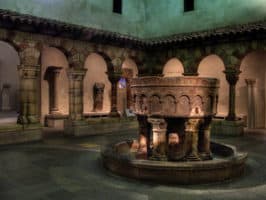
On this episode of 5 Minutes in Church History, Dr. Stephen Nichols walks us through the Philadelphia Museum of Art and its collection of medieval paintings, sculptures, and manuscripts.
 The Philadelphia Museum of Art has a wonderful collection of medieval art that teaches us a great deal about medieval church life, medieval theology, and even about the medieval world. The first thing we realize about medieval art is that it is dominated by religious themes and depictions of biblical events. This makes sense because the Middle Ages was the era of Christendom. The second thing we notice about medieval art is that it was done in a variety of media. Of course, there was painting, sculpture, and illuminated manuscripts, but we also have stained glass, mosaics, and tapestries. Artists also worked with fine metals and precious jewels. The medieval period was also the beginning of fresco paintings—murals that used wet limestone and pigments mixed with water. This technique reached its apex at the Sistine Chapel.
The Philadelphia Museum of Art has a wonderful collection of medieval art that teaches us a great deal about medieval church life, medieval theology, and even about the medieval world. The first thing we realize about medieval art is that it is dominated by religious themes and depictions of biblical events. This makes sense because the Middle Ages was the era of Christendom. The second thing we notice about medieval art is that it was done in a variety of media. Of course, there was painting, sculpture, and illuminated manuscripts, but we also have stained glass, mosaics, and tapestries. Artists also worked with fine metals and precious jewels. The medieval period was also the beginning of fresco paintings—murals that used wet limestone and pigments mixed with water. This technique reached its apex at the Sistine Chapel.
In the Philadelphia Museum of Art, there is a collection of medieval artifacts known as reliquaries. Reliquaries are highly decorated shrines of various shapes that were made to hold relics. Relics related to Jesus, Mary, the Apostles, and saints could be found throughout cathedrals in Europe during the Middle Ages. There are a number of these reliquaries in the collection at the Philadelphia Museum of Art. One is a little round locket box with a carving of a sheep on it. It says, in Latin, Agnus Deo (the lamb of God). It’s from the period of Pope Urban V (1378–89). Inside is a medal made of wax from one of the Easter candles that was used in one of the services at Saint John Lateran Basilica. This was understood to be a holy service. The Easter waxes would have been saved and sent to the pope’s friends all over the world. This one eventually ended up in Philadelphia.
There is also a reliquary that’s shaped like an arm with a hand raised in the gesture of a priest or bishop giving a blessing—a common form for reliquaries that can be seen all throughout Europe. The one at the Philadelphia Museum of Art is called the Arm Reliquary of Saint Babylas. It is silver with glass stones, crystals, and amethysts.
Besides these reliquaries, there are also medieval paintings of the saints at the Philadelphia Museum of Art. There is a four-panel painting dedicated to the story of Sebastian. He was a high-ranking Roman military official who converted to Christianity in AD 283. Under Diocletian, the emperor before Constantine, Sebastian was martyred for his faith during an intense time of persecution. In the Middle Ages, a significant legend grew up around the life of Sabastian. This particular painting consists of four panels, and it was an altarpiece in Marseille that was removed and dismantled during the French Revolution. One of the panels depicts Sebastian destroying idols. One depicts him being shot by arrows. Legend has it that he was miraculously healed from these wounds but was again captured by Diocletian’s soldiers and martyred. The last panel depicts his martyrdom.
Another notable painting of a saint is a very tiny painting—only 5 by 5 3/4 inches—by Jan van Eyck titled Saint Francis of Assisi Receiving the Stigmata. In this painting, Francis of Assisi is kneeling in the foreground, but the most fascinating thing about this painting is the detail in the background. If you look in the background, there is a city and, in the most incredible detail, horses gathered around a lake. Van Eyck even painted the horses with saddles. The detail is staggering for a painting that was likely intended for pilgrims to carry with them on pilgrimage.
This is just a sampling of some of the art that you will find in the medieval collection at the Philadelphia Museum of Art that gives us great insight into the medieval church and the medieval world.
Stay connected with 5 Minutes in Church History by getting the weekly podcast on iTunes, SoundCloud, or via RSS. You can also subscribe to the blog via RSS and follow us on Twitter and Facebook.
(This podcast is by Ligonier Ministries. Discovered by Christian Podcast Central and our community — copyright is owned by the publisher, not Christian Podcast Central, and audio is streamed directly from their servers.)